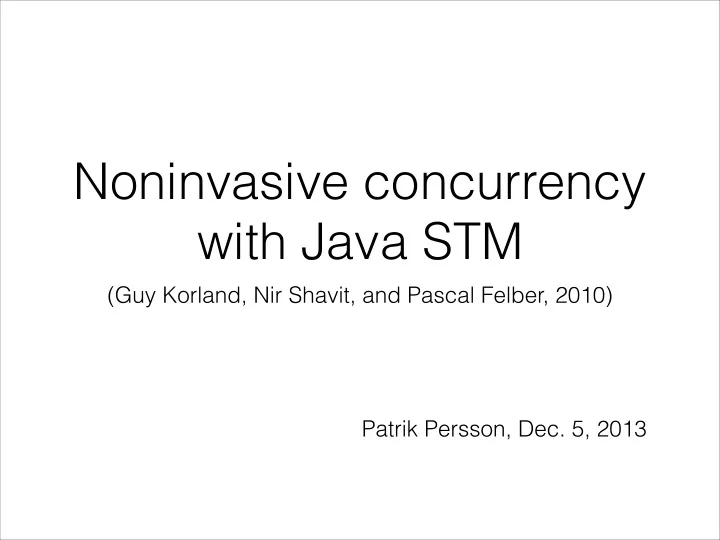

Noninvasive concurrency with Java STM (Guy Korland, Nir Shavit, and Pascal Felber, 2010) � � � � Patrik Persson, Dec. 5, 2013
Previously on Software Transactional Memory • STM is about opportunistic concurrency control: try to commit, detect conflicts, retry transaction if needed • Harris & Fraser, 2003: proposed atomic construct for Java • 2013: STM is no longer science fiction • STM support for C++ in gcc 4.7 (seems primitive though) • Several approaches for Java being investigated, aiming for modified VM, compiler, or dedicated frameworks
Korland/Shavit/Felber: Java with annotations • Annotations checked at load time • On-the-fly modification of class files when loaded • Create instrumented (transaction-aware) versions of classes • Per-method only
On-the-fly modifications to loaded classes • Getters & setters introduced • Duplicate methods (transaction-aware, when called from @Atomic methods)
On-the-fly modifications, cont’d
Adding support for atomic blocks
In summary • A (somewhat) realistic system for STM in Java • Implementation flaky? • Based on annotations & on-the-fly instrumentation of classes during loading • Annotations are per-method; atomic blocks supported using separate, JastAdd-based source-to-source translation tool • You could actually use this for concurrent programs…
@Atomic exercise Example: AtomicAccount One set of threads deposits, another set withdraws (the same amounts) public class AtomicAccount { private static long balance = 0; If everything works, final balance is 0 � Your task � public static void deposit(long n) { balance += n; 1. Run it a few times without synchronization. It } hopefully doesn’t work. � public static long getBalance() { 2. Make it work using synchronized . return balance; } 3. Make it work using @Atomic instead � – not synchronized . … } 4. Measure performance of synchronized vs. @Atomic . Experiment with the number of threads. Be prepared to force-terminate your program. The code, with instructions for building and running, is available at http://fileadmin.cs.lth.se/cs/Education/EDA015F/2013/AtomicAccount.java
Recommend
More recommend